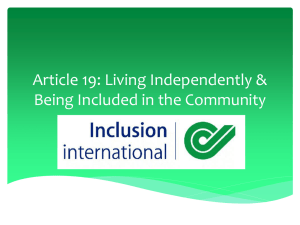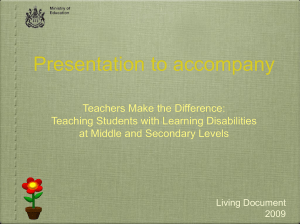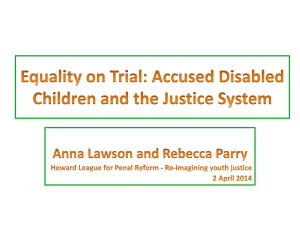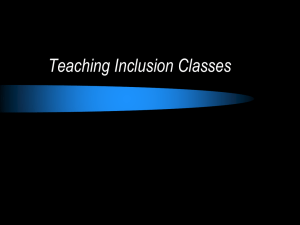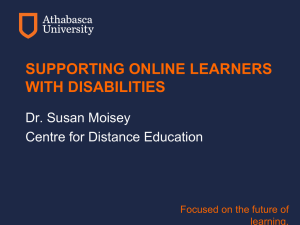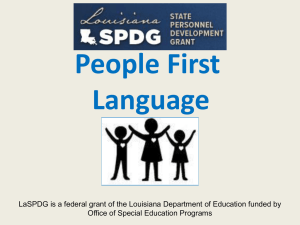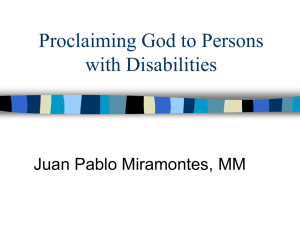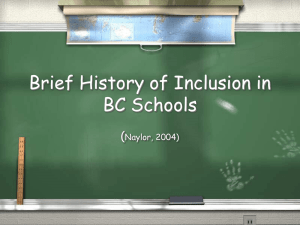Inclusion in Preschool for Children with Physical and Developmental
advertisement
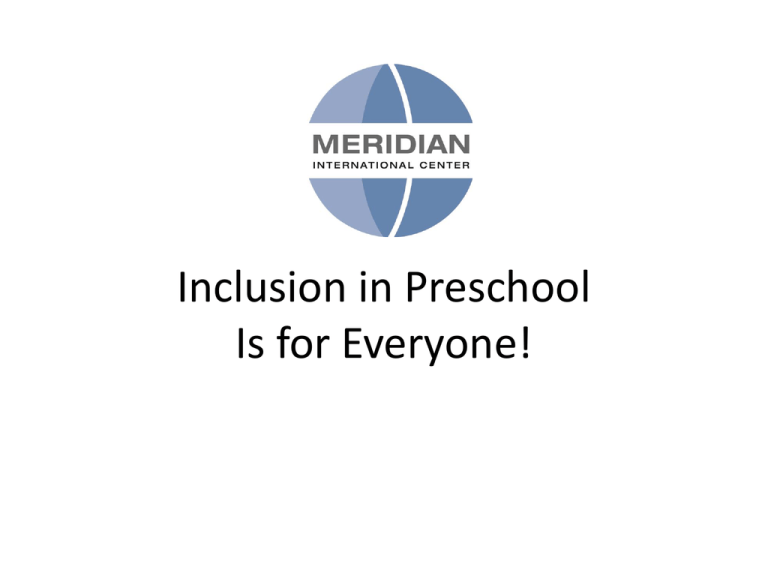
Inclusion in Preschool Is for Everyone! Learning Objectives: • Understand the benefits of inclusion for typically developing children, children with disabilities and communities • Know five educational goals for preschool children regardless of disability status • Know five levels of adaptation for children with disabilities • Understand how to adapt activities to children’s special needs Benefits of Inclusion • For typically developing children • For children with disabilities • For families of typically developing children • For families of children with disabilities • For the community Benefits for Typically Developing Children • Can develop accurate views of individuals with disabilities • Can develop positive attitudes toward people who are different than they are • Can learn about altruistic behavior and feel good about helping others • Have models of people who overcome challenges Benefits for Children with Disabilities • Have same educational opportunities as others • Avoid the negative attitudes of people who have not had contact with disabilities • Learn social and communication skills with typically developing children • Have realistic life experiences that prepare them to live in their community • May develop friendships with typically developing children Benefits for Families of Typically Developing Children • Have opportunities to interact with families of children with disabilities and support them • Be better able to teach their children about individual differences and acceptance of people who are different from them Benefits for Families of Children with Disabilities • Learn about typical development, and notice areas in which their children with disabilities are developing well • Reduce sense of isolation from others in their communities • Develop relationships with families of typically developing children who can provide them with emotional support Benefits for Communities • Offers a more affordable way to get children with special needs into a school program at an early age • Can decrease need for special education services throughout the educational lives of children with disabilities Goals of Preschool Education that Apply to All Children • Becoming more confident learners • Learning to interact positively with peers • Learning to respect others and to celebrate differences • Learning to communicate effectively • Acquiring and using problemsolving skills Issues in Selection of Preschools for Inclusion Programs • Physical facility • Transportation • Staffing Models of Inclusion for Children with Special Needs • Full inclusion in class with typically developing children • Partial inclusion with some individualized instruction • Specialized classroom for children with special needs Five Levels of Adaptations to Children’s Special Needs • • • • • Environment Activity Materials Instructions Assistance Adaptation: Environment • Make seating, materials and activities accessible for all children – Room setup – Adaptive equipment – Positioning of child in the room Adaptation: Activity • Consider whether you need to adjust the following: -- length of time allowed for the activity -- the types of responses required of the children Adaptation: Materials • Examples: -- making a crayon or pencil larger by wrapping foam or play doh around it -- substituting a hollow ball or a ball made of foam for a regular ball Adaptation: Instructions • May be modified by: -- using pictures as well as words -- giving instructions one step at a time rather than all at once -- giving a child with disabilities a “helper”– another child or adult who can repeat instructions as needed Adaptation: Assistance • Encourage children to work in pairs, either with individual responses or with a single response for the pair • Have the teacher provide special help as needed for the project Adapting Activities to Children’s Special Needs 1. Break down the activity into steps. 2. Think about what steps the child with special needs can do, and what steps will need to be modified. 3. Determine the best modifications based on least intrusive means. 4. Notice how the child does with the modifications, so that you can use this information for other activities. Two Views of the Classroom • Some teachers think of their class as a group in which all children are expected to conform to the whole. • Other teachers think of their class as a group of individuals, each with their own personalities, skills and needs. Teachers who think the second way have more success with inclusion. Celebrate Differences! • This is the principle that makes the second group do well. For them, it isn’t just the children with special needs who need adaptations. Every child needs them from time to time, and to help children learn up to their potential and to be eager learners, it is important to recognize those needs and accommodate them as best we can in the classroom.
